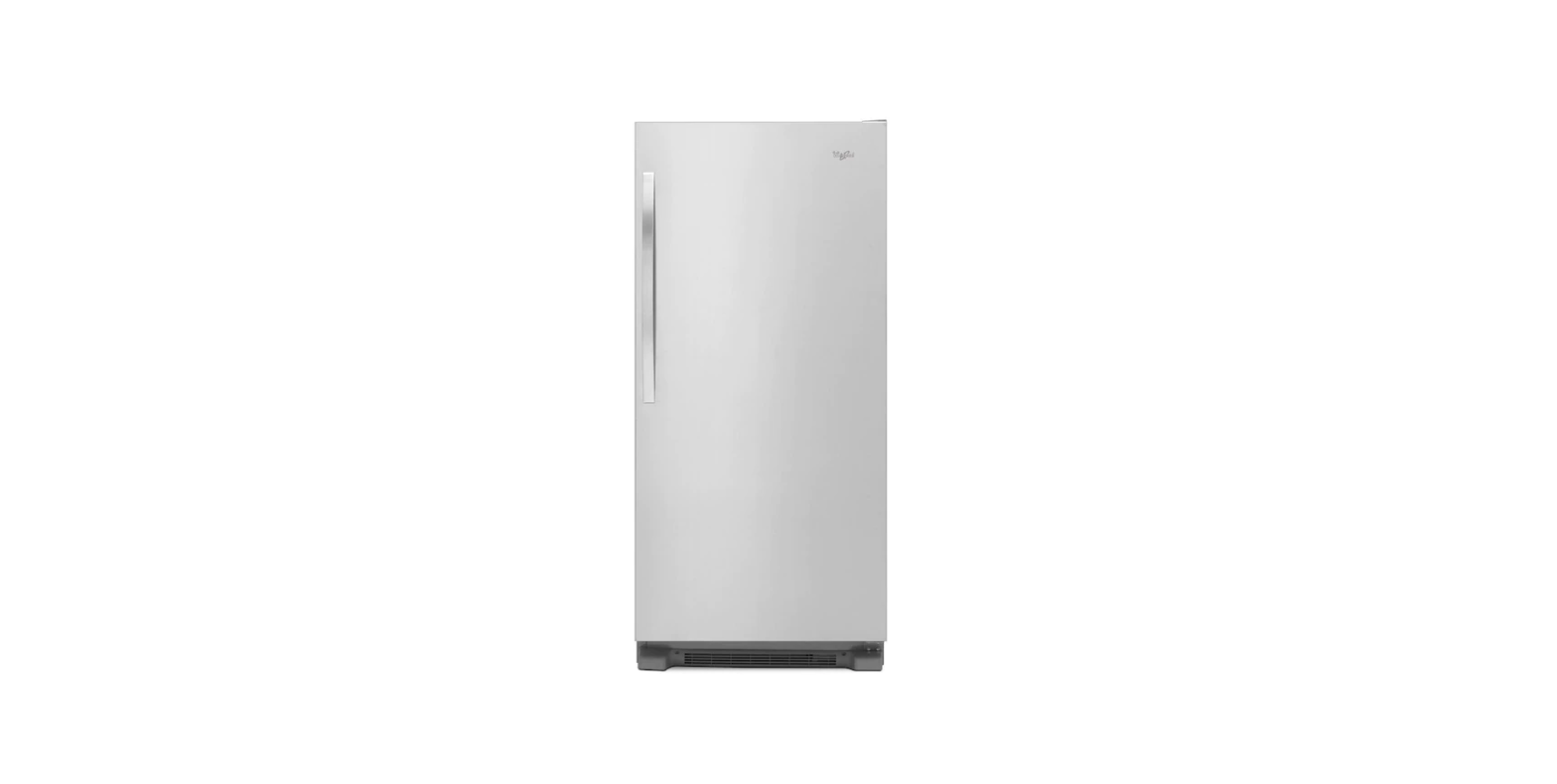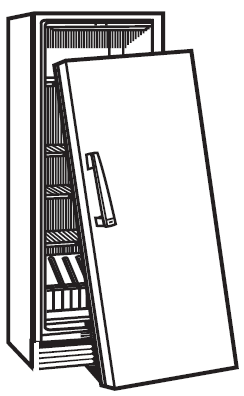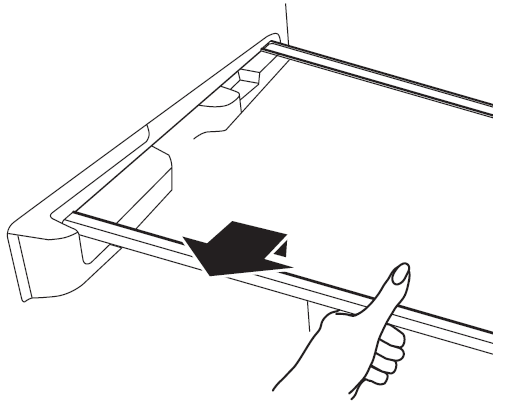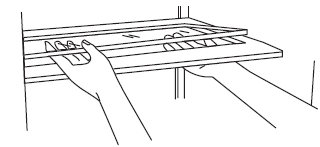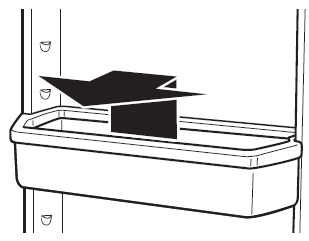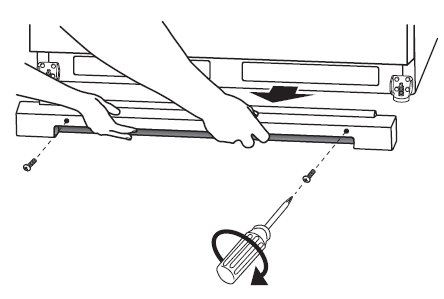Whirlpool W11320187A Refrigerator

SAFETY
Your safety and the safety of others are very importantWe have provided many important safety messages in this manual and on your appliance. Always read and obey all safety messages.
- This is the safety alert symbol.
- This symbol alerts you to potential hazards that can kill or hurt you and others.
- All safety messages will follow the safety alert symbol and either the word “DANGER” or “WARNING.” These words mean:
DANGER
You can be killed or seriously injured if you don’t immediately follow instructions.
WARNINGYou can be killed or seriously injured if you don’t follow instructions.
All safety messages will tell you what the potential hazard is, tell you how to reduce the chance of injury, and tell you what can happen if the instructions are not followed.
IMPORTANT SAFETY INSTRUCTIONS
WARNING:To reduce the risk of fire, electric shock or injury to persons when using the appliance, follow basic precautions, including the following:
- Plug into a grounded 3-prong outlet.
- Do not remove the ground prong.
- Do not use an adapter.
- Do not use an extension cord.
- Disconnect power before servicing.
- Replace all parts and panels before operating.
- Remove doors from your old appliance.
- Use non-flammable cleaner.
- Keep flammable materials and vapors, such as gasoline, well away from the appliance.
- Use two or more people to move and install the appliance.
- Disconnect the power before installing the ice maker (on ice maker kit-ready models only).
- Ice maker kit ECKMF95 can be added to some models.
- A qualified service technician must install the water line and ice maker. See installation instructions supplied with ice maker kit ECKMF95 for complete details.
- Connect to a potable water supply only.
- This appliance is not intended for use by persons (including children) with reduced physical, sensory or mental capabilities, or lack of experience and knowledge, unless they have been given supervision or instruction concerning use of the appliance by a person responsible for their safety.
- Children should be supervised to ensure that they do not play with the appliance.
- If the supply cord is damaged, it must be replaced by the manufacturer, its service agent or similarly qualified person in order to avoid a hazard.
- Do not store explosive substances such as aerosol can with a flammable propellant in this appliance.
- This appliance is intended to be used in household and similar applications such as
- Staff kitchen areas in shops, offices and other working environments;
- Farm houses and by clients in hotels, motels and other residential type environments;
- Bed and breakfast type environments;
- Catering and similar non-retail applications.
WARNING
Suffocation Hazard
- Remove doors or lid from your old freezer or refrigerator.
- Failure to do so can result in death or brain damage.
IMPORTANT:Child entrapment and suffocation are not problems of the past. Junked or abandoned freezers or refrigerators are still dangerous — even if they will sit for “just a few days.” If you are getting rid of your old refrigerator or freezer, please follow these instructions to help prevent accidents.
Before You Throw Away Your Old Freezer or Refrigerator:
- Take off the doors or lid.
- Leave the shelves in place so that children may not easily climb inside.

Important information to know about disposal of refrigerants:Dispose of refrigerator in accordance with Federal and Local regulations. Refrigerants must be evacuated by a licensed, EPA certified refrigerant technician in accordance with established procedures.
INSTALLING YOUR REFRIGERATOR
Unpacking
WARNING
Excessive Weight Hazard
- Use two or more people to move and install refrigerator.
- Failure to do so can result in back or other injury.
Remove Packaging Materials
- Remove tape and glue residue from surfaces before turning on the refrigerator. Rub a small amount of liquid dish soap over the adhesive with your fingers. Wipe with warm water and dry.
- Do not use sharp instruments, rubbing alcohol, flammable fluids, or abrasive cleaners to remove tape or glue. These products can damage the surface of your refrigerator. For more information, see “Safety.”
When Moving Your Refrigerator:Your refrigerator is heavy. When moving the refrigerator for cleaning or service, be sure to cover the floor with cardboard or hardboard to avoid floor damage. Always pull the refrigerator straight out when moving it. Do not wiggle or “walk” the refrigerator when trying to move it, as floor damage could occur.
Clean Before UsingAfter you remove all of the packaging materials, clean the inside of your refrigerator before using it. See the cleaning instructions in the “Caring For Your Refrigerator” section.
Important information to know about glass shelves and covers:Do not clean glass shelves or covers with warm water when they are cold. Shelves and covers may break if exposed to sudden temperature changes or impact, such as bumping. Tempered glass is designed to shatter into many small, pebble-size pieces. This is normal. Glass shelves and covers are heavy. Use both hands when removing them to avoid dropping.
Location Requirements
WARNING
Explosion Hazard
- Keep flammable materials and vapors, such as gasoline, away from refrigerator.
- Failure to do so can result in death, explosion, or fire.
Ventilation and Clearance
- Keep flammable materials and vapors, such as gasoline, away from refrigerator.
- Do not cover the refrigerator with items such as blankets, sheets, tablecloths, etc. This reduces air circulation.
- Allow at least 1″ (25.4 mm) between the back of the refrigerator and the wall. If the refrigerator is to be next to a fixed wall, leave extra space on the hinge side so the door can open wider.
TemperatureYour refrigerator operates most efficiently when located in an area where the temperature will not fall below 40°F (5°C). Place your refrigerator in a location where the temperature will not fall below this recommended temperature.
Upon Moving to Final Location
NOTE:This refrigerator may be installed side by side with another freezer or refrigerator. Allow for a 1″ (25.4 mm) space behind the refrigerator and a 1/4″ (6.4 mm) clearance between the appliances.
Electrical Requirements
WARNING
Electrical Shock Hazard
- Plug into a grounded 3 prong outlet.
- Do not remove ground prong.
- Do not use an adapter.
- Do not use an extension cord.
- Failure to follow these instructions can result in death, fire, or electrical shock.
Before you move your refrigerator into its final location, it is important to make sure you have the proper electrical connection.
Recommended Grounding MethodA 115 V, 60 Hz, AC only, 15 or 20 A fused, grounded electrical supply is required. It is recommended that a separate circuit serving only your refrigerator be provided. Use an outlet that cannot be turned off by a switch. Do not use an extension cord.
NOTE:Before performing any type of installation, cleaning, or removing a light bulb, press and hold TEMP SETTING for 3 seconds to turn off cooling, and then disconnect the refrigerator from the electrical source.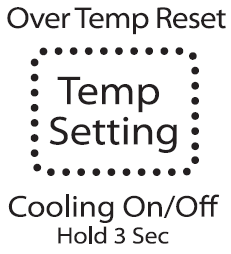
Refrigerator Door
Tools Needed:5/16″ hex-head socket wrench, 3/8″ hex-head socket wrench, flat 2″ putty knife.
IMPORTANT:
- Depending on the width of the opening, you may need to remove the handle or door to move the refrigerator into the house.
- All graphics referenced in the following instructions are included later in this section after “Final Steps.” The graphic may be reversed if door swing is reversed.
- Before you begin, turn the control off and remove food and adjustable door or utility bins from door.
WARNING
Excessive Weight HazardUse two or more people to lift the refrigerator door. Failure to do so can result in back or other injury.
Remove and Replace the Handle
To Remove the Handle:
- Loosen the setscrews located on the side of handle at each end. See “Handle” graphic.
- Remove the handle from the grommets.
To Replace the Handle:
- Place the handle onto the grommets, making sure the grommets are fitted into the handle holes.
- Tighten the upper and lower setscrews with the hex key provided. See “Handle” graphic. Do not over-tighten the setscrews.
WARNING
Electrical Shock Hazard
- Disconnect power before removing doors.
- Failure to do so can result in death or electrical shock.

- Unplug refrigerator or disconnect power.
- Keep the refrigerator door closed until you are ready to lift it free from the cabinet.NOTE: Provide additional support for the door while the hinges are being moved. Do not depend on the door magnets to hold the door in place while you are working.
- Remove the parts for the top hinge as shown in “Top Hinge” graphic.
- Lift the refrigerator door free from the lower hinge and cabinet and set aside.
- Remove the 4 hex-head hinge screws and bottom hinge assembly. See “Bottom Hinge” graphic.
Reverse Door (optional on some models)
IMPORTANT:If you want to reverse your door so that it opens in the opposite direction, continue with “Reverse Door (optional on some models)” instructions. If you are not reversing the door, see “Replace Door and Hinges.”
Cabinet
- Remove the cabinet hinge hole plugs from the cabinet top and move them to the opposite side hinge holes as shown in Graphic 2 in “Door Swing Reversal and Handle Removal” section.
- Remove the bottom hinge pin from the hinge bracket.
- Remove the decals covering the holes on the opposite side of the bottom hinge.
- Reinstall the bottom hinge pin in the alternate hole in the hinge bracket. See Graphic 3 in “Door Swing Reversal and Handle Removal” section.
- Reinstall the hinge bracket to the cabinet with the 4 hex-head hinge screws.
Door
- Remove the hinge thimble hole plug from the top of the door.
- Remove the door stop from the bottom of the door.
- Move the door stop to the opposite side, making sure that the hole in the door stop plate is aligned perfectly with the hole in the door for the bottom hinge pin.
- Using the screws removed in Step 2, fasten the door stop bracket to the bottom of the door.
- Tighten all screws. Set aside the door until the bottom hinge is in place.
Replace Door and HingesNOTE: Graphic may be reversed if door swing is reversed.
- Replace the parts for the bottom hinge as shown and tighten screws. See “Bottom Hinge” graphic. Replace the refrigerator door.NOTE: Provide additional support for the door while the hinges are being moved. Do not depend on the door magnets to hold the door in place while you are working.
- Assemble the parts of the top hinge as shown in the “Top Hinge” graphic. Do not tighten the screws completely.
Final Steps
WARNING
Electrical Shock Hazard
- Plug into a grounded 3 prong outlet.
- Do not remove ground prong.
- Do not use an adapter.
- Do not use an extension cord.
- Failure to follow these instructions can result in death, fire, or electrical shock.
- Plug into a grounded 3 prong outlet.
- Reset the control. See “Using the Control.”
- Return all removable door parts to door and food to refrigerator.
WARNING
Electrical Shock Hazard
- Disconnect power before removing doors.
- Failure to do so can result in death or electrical shock.
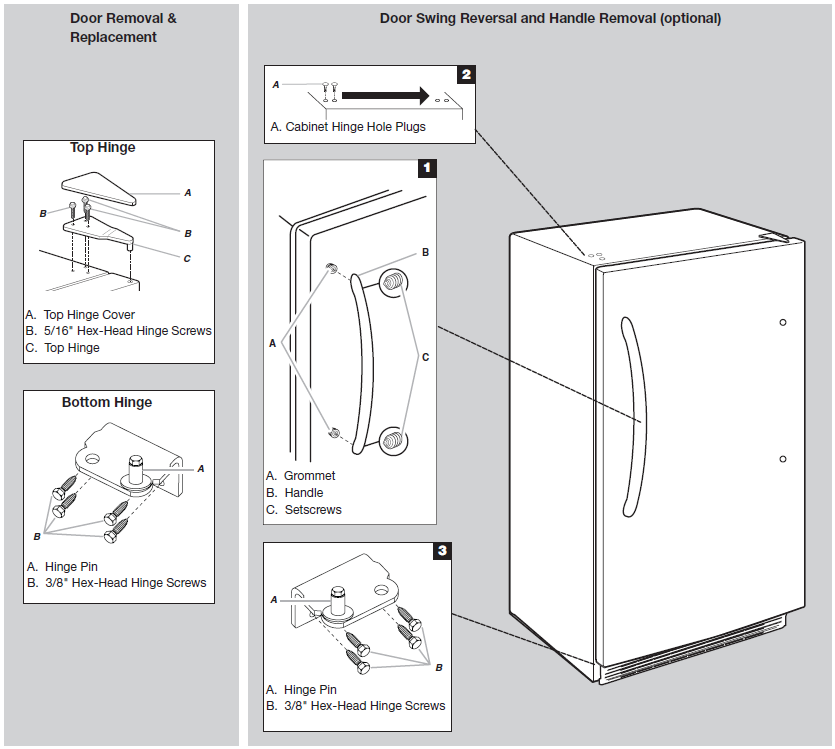
Refrigerator Leveling and Door ClosingYour refrigerator has two front adjustable legs — one on each side. The back of the refrigerator rests on two fixed rollers. The base grille covers the adjustable brake feet and roller assemblies located at the bottom of the refrigerator below the refrigerator door. Before making any adjustments, remove the base grille and move the refrigerator to its final location.
Tools Needed:1/4″ hex driver, Phillips head screwdriver
- Remove the base grille screws. Grasp the grille firmly and pull it toward you. Open the refrigerator door to access the brake feet.NOTE: To allow the refrigerator to roll more easily, raise the brake feet by turning them counterclockwise. The front roll-ers will be touching the floor.

- Move the refrigerator to its final location.
- Lower the brake feet, by turning them clockwise, until the rollers are off the floor and both brake feet are snug against the floor. This keeps the refrigerator from rolling forward when you are opening the refrigerator door.IMPORTANT: If you need to make further adjustments involving the brake feet, you must turn both brake feet the same amount to keep the refrigerator level.
- Make sure the door closes easily. If you are satisfied with the door opening and closing, skip the next section. If, however, the door does not close easily or the door pops open, adjust the tilt.
To Adjust the Cabinet Tilt:NOTE: Having someone push against the top of the refrigerator takes some weight off the brake feet. This makes it easier to turn them.
- Open the refrigerator door. Use a 1/4″ hex driver to turn both brake feet clockwise the same amount. This will raise the front of the refrigerator. It may take several turns to allow the door to close more easily.

- A. Brake foot
- B. Front roller
- C. 1/4″ hex driver
- Make sure the refrigerator is steady. If the refrigerator seems unsteady or rolls forward when the door is pulled open, adjust the brake feet.
To Steady the Refrigerator:Open the refrigerator door. Using a 1/4″ hex driver, turn both brake feet clockwise the same amount until the brake feet are snug against the floor. Check again. If not satisfied, continue to adjust the brake feet by half turns of the screw until the refrigerator does not roll forward when the door is opened.
- Replace the base grille by aligning the ends of the grille with the leveling assemblies on each side and snapping the grille into place. Reinstall the Phillips screws.
Normal SoundsYour new refrigerator may make sounds that your old one didn’t make. Because the sounds are new to you, you might be concerned about them. Most of the new sounds are normal. Hard surfaces, like the floor, walls, and cabinets, can make the sounds seem louder. The following describes the kinds of sounds and what may be making them.
- Your refrigerator is designed to run more efficiently to keep your food items at the desired temperatures and to minimize energy usage. The high-efficiency compressor and fans may cause your refrigerator to run longer than your old one. You may also hear a pulsating or high-pitched sound from the compressor or fans adjusting to optimize performance.
- You may hear the evaporator fan motor circulating air through the refrigerator compartment. The fan speed may increase as you open the doors or add warm food.
- Rattling noises may come from the flow of refrigerant or items stored on top of the refrigerator.
- Water dripping on the defrost heater during a Defrost cycle may cause a sizzling sound.
- As each cycle ends, you may hear a gurgling sound due to the refrigerant flowing in your refrigerator.
- Contraction and expansion of the inside walls may cause a popping noise.
- You may hear air being forced over the condenser by the condenser fan.
- You may hear water running into the drain pan during the Defrost cycle.
OPERATING YOUR REFRIGERATOR
Ensuring Proper Air CirculationIn order to ensure proper temperature, you need to permit proper airflow in the refrigerator. As shown in the illustration, cool air enters from the refrigerator wall and moves down. The air then recirculates through the vent near the bottom.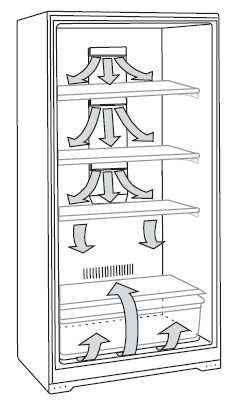
Do not block any of these vents with food packages. If the vents are blocked, airflow will be restricted and temperature and moisture problems may occur.
IMPORTANT: To avoid odor transfer and drying out of food, wrap, or cover foods tightly.
Using the ControlThe temperature control is located at the top front of the refrigerator compartment.
Temperature ControlFor your convenience, the temperature control is preset at the factory. When you first install your refrigerator, check that the control is still set to the recommended setting as shown.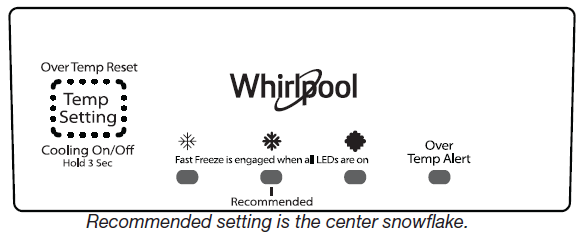
IMPORTANT:
- The recommended setting is designed to maintain the temperature at or near 37°F (3°C) under normal operating conditions.
- Wait 24 hours before you put food into the refrigerator. If you add food before the refrigerator has cooled completely, your food may spoil.NOTE: Adjusting the temperature set point to a colder-than recommended setting will not cool the refrigerator any faster.
- The preset temperature setting should be correct for normal household usage. The control is set correctly when milk or juice is as cold as you like.
- When the refrigerator is first started, the compressor will run constantly until the refrigerator is cooled. It may take up to 6 or 8 hours (or longer), depending on room temperature and number of times the refrigerator door is opened. After the refrigerator is cooled, the compressor will turn on and off as needed to keep the refrigerator at the proper temperature.
- The outside of your refrigerator may feel warm. This is normal. The refrigerator’s design and main function isto remove heat from packages and air space inside the refrigerator. The heat is transferred to the room air, making the outside of the refrigerator feel warm.
Adjusting ControlIf you need to adjust the temperature in the refrigerator compartment, press TEMP SETTING to display the desired temperature setting from the snowflake on the left (least cold) to the snowflake on the right (coldest).
NOTE:Except when starting the refrigerator, do not adjust the control more than one setting at a time. Wait 24 hours between adjustments for the temperature to stabilize.
Cooling On/OffYour refrigerator will not cool when cooling is turned off. To turn cooling off, press and hold TEMP SETTING for 3 seconds. In the Off condition, none of the lights on the control panel will be illuminated. The main refrigerator light bulb will still operate. To turn cooling on, press and hold TEMP SETTING for 3 seconds. When cooling is ON, the control panel lights will be illuminated.
Fast CoolUse this feature to assist with periods of high refrigerator use, full grocery loads or temporarily warm room temperature. To activate Fast Cool, press TEMP SETTING until all the snowflake positions are illuminated simultaneously. The refrigerator will remain in the Fast Cool setting for 24 hours after the extra-low temperature is reached. Once the time has expired, the refrigerator will return to the previous temperature setting. Fast Cool may be manually turned off by pressing the TEMP SETTING button to select the desired temperature setting from the snowflake on the left (least cold) to the snowflake on the right (coldest).
Over-Temperature Alert (on some models)The Over Temperature Alert lets you know if the refrigerator temperature has risen to 54°F (12°C) or higher. This alert feature will sound a continuous alert tone and repeatedly flash a red light on the control panel. The tone can be turned off by pressing TEMP SETTING on the control panel once. As you press TEMP SETTING, the red light will then also change from flashing to continuously illuminated. The red light will remain illuminated until the refrigerator temperature falls below 54°F (12°C).
NOTE:If the red light on the control panel is repeatedly flashing, but the alert tone is not sounding, this means that an over temperature condition has occurred but the refrigerator temperature has since returned to below 54°F (12°C). To turn off the red light indicator for this condition, press TEMP SETTING on the control panel once.
Door Ajar Alarm (on some models)The Door Ajar alarm lets you know when the refrigerator door has been open for 5 minutes or longer and the cooling is turned on. This alarm feature will sound an alert tone that will repeat every 2 minutes. Close the door to turn off the tone. The feature is reset and will reactivate when the door is again left open for 5 minutes.
NOTE:To mute the alert tone while keeping the door open, such as while cleaning the inside of the refrigerator, press TEMP SETTING on the control panel. The alert tone will be temporarily turned off.
Key Eject Lock (on some models)To lock or unlock the refrigerator, you must hold the key in the lock while turning. The lock is spring loaded, so the key cannot be left in the lock.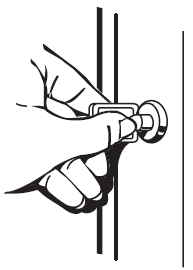
If the key is lost, contact your dealer for a replacement. Always give the model and serial number of your refrigerator when requesting a replacement key.
NOTE:Keep the key out of the reach of children. Do not keep the key close to the refrigerator.
Refrigerator Features
Important information to know about glass shelves and covers:Do not clean glass shelves or covers with warm water when they are cold. Shelves and covers may break if exposed to sudden temperature changes or impact, such as bumping. Tempered glass is designed to shatter into many small, pebble-size pieces. This is normal. Glass shelves and covers are heavy. Use both hands when removing them to avoid dropping.
Refrigerator ShelvesStore similar foods together and adjust the shelves to fit different heights. This reduces the time the refrigerator door is open and saves energy.
To Remove and Replace a Shelf:
- Remove the shelf by lifting straight up and pulling the shelf out.

- Replace the shelf by lowering the shelf onto the supports on the side wall.
Crisper Drawers
To Remove and Replace a Drawer:
- Slide drawer straight out to the stop. Lift the front of the drawer and slide it out the rest of the way.
- Replace a drawer by sliding it back in, fully past the stop.
Crisper Cover
To Remove the Crisper(s) Cover:
- Remove crisper(s). Hold the glass, insert firmly with one hand, and press up in the center of the glass insert until it rises above the plastic frame. Slowly slide the glass insert forward to remove.
- Lift the cover frame and remove it.

To Replace Crisper Cover:
- Fit the back of the cover frame into the supports on the side walls of the refrigerator. Lower the front of the cover frame into place.
- Slide the rear of the glass insert into the cover frame and lower the front into place.
Crisper Humidity Control (on some models)You can adjust the amount of humidity in the moisture-sealed crisper using the settings between “+” and “-”. “-” (open) lets moist air out of the crisper for best storage of fruits and vegetables with skins.
- Fruit: Wash, let dry, and store in refrigerator in plastic bag in crisper. Do not wash or hull berries until they are ready to use. Sort and keep berries in original container in crisper.
- Vegetables with skins: Place in plastic bag or plastic container and store in crisper. “+” (closed) keeps moist air in the crisper for best storage of fresh, leafy vegetables.
- Leafy vegetables: Wash in cold water, drain, and trim or tear off bruised and discolored areas. Place in plastic bag or plastic container and store in crisper.
Door Bin
To Remove and Replace the Bin:
- Remove the bin by tipping the front of the bin forward and sliding out.
- Replace the bin by sliding it in above the desired support and tilting it back into place.

CARING FOR YOUR REFRIGERATOR
Cleaning Your Refrigerator
WARNING
Explosion Hazard
- Use nonflammable cleaner.
- Failure to do so can result in death, explosion, or fire.
Clean the refrigerator about once a month to keep odors from building up. Wipe up spills immediately.
To Clean Your Refrigerator:Complete cleaning should be done at least once a year.
- Press and hold TEMP SETTING for 3 seconds to turn off cooling.
- Unplug refrigerator or disconnect power.
- Remove all removable parts from inside, such as shelves, crispers, etc.
- Hand wash, rinse, and dry removable parts and interior surfaces thoroughly. Use a clean sponge or soft cloth and a mild detergent in warm water.
- Do not use abrasive or harsh cleaners such as window sprays, scouring cleansers, flammable fluids, cleaning waxes, concentrated detergents, bleaches or cleansers containing petroleum products on plastic parts, interior and door liners, or gaskets. Do not use paper towels, scouring pads, or other harsh cleaning tools. These can scratch or damage materials.
- To help remove odors, you can wash interior walls with a mixture of warm water and baking soda (2 tbs to 1 qt [26 g to 0.95 L] of water).
- Replace the removable parts.
- Use the appropriate cleaning method for your exterior finish. Painted Metal: Wash exteriors with a clean sponge orsoft cloth and a mild detergent in warm water. Do not use abrasive or harsh cleaners or cleaners designed for stainless steel. Dry thoroughly with a soft cloth.
- Clean the condenser coils regularly. Coils may need to be cleaned as often as every other month. This may help save energy.
- Open the refrigerator door and remove the base grille by removing 2 Phillips-head screws and pulling the grille toward you.

- Use a vacuum with an extended attachment to clean the condenser coils when they are dusty or dirty.
- Replace the base grille by aligning the ends of the grille with the leveling assemblies on each side and snapping the grille into place. Reinstall the screws.
- Open the refrigerator door and remove the base grille by removing 2 Phillips-head screws and pulling the grille toward you.
- Plug in refrigerator or reconnect power.
- Set temperature control to desired setting. See “Using the Control.”
Changing the Light Bulb(s)
IMPORTANT: The lighting system in this appliance may consist of:
- Sealed LED modules
- LED Bulbs
- Incandescent Bulbs
Sealed LED module is an LED which does not need to be replaced. If a Sealed LED module(s) do not illuminate when the refrigerator and/or freezer door is opened, call for assistance or service. See “Warranty” for contact information. If a LED Bulb does not illuminate when the refrigerator and/ or freezer door is opened, replace with like bulb following this procedure:
- Unplug the appliance or disconnect power.
- Remove the light shield.
- Remove the hardware holding the light shield in place.
- Top of the appliance compartment – Slide the light shield toward the back of the compartment to release it from the light assembly.
- Replace the burned-out bulb(s) with a LED bulb of the same size, shape and wattage.
- Order Part Number W10805744 (3.6 W).NOTE: Some LED replacement bulbs are not recommended for wet/damp environments. The refrigerator and freezer compartments are considered to be wet/damp environments. If using a brand of LED bulb other than the recommended LED bulb, before installation, read and follow all instructions on the LED packaging.
- Replace the light shield by inserting the tabs on the shield into the liner holes on each side of the light assembly. Slide the shield toward the front until it locks into place.NOTE: To avoid damaging the light shield, do not force the shield beyond the locking Point.
- Replace the hardware that holds the shield in place.
- Plug in the appliance or reconnect power.
If an incandescent bulb does not illuminate when the refrigerator and/or freezer door is opened, replace with like bulb using the same procedure outlined above. Replace burned out bulb with only incandescent bulb(s) of the same size, shape and wattage (maximum 40 W) designed for household appliances.
Power InterruptionsIf the power will be out for 24 hours or less, keep the door closed to help food stay cold and frozen. If the power will be out for more than 24 hours, consume or can perishable food at once.
REMEMBER: If the condition of the food is poor, dispose of it.
Vacation and Moving Care
VacationsIf you choose to leave the refrigerator on while you’re away, use up any perishables and freeze other items. If you choose to turn the refrigerator off before you leave, follow these steps.
- Remove all food from the refrigerator.
- Turn the control to the Off position. See “Using the Control.”
- Clean refrigerator, wipe it, and dry well.
- Tape rubber or wood blocks to the tops of both doors to prop them open far enough for air to get in. This stops odor and mold from building up.
MovingWhen you are moving your refrigerator to a new home, follow these steps to prepare it for the move.
- Remove all food from the refrigerator.
- Turn the control to the Off position. See “Using the Control.”
- Unplug refrigerator.
- Empty water from the defrost pan.
- Clean, wipe, and dry thoroughly.
- Take out all removable parts, wrap them well, and tape them together so they don’t shift and rattle during the move.
- Tape the doors shut and the power cord to the refrigerator cabinet.
When you get to your new home, put everything back and refer to “Installing Your Refrigerator” for preparation instructions.
TROUBLESHOOTING
First try the solutions suggested here. If you need further assistance or more recommendations that may help you avoid a service call, refer to the warranty page in this manual or visit www.whirlpool.com/product_help In Canada, visit http://www.whirlpool.ca.
Contact us by mail with any questions or concerns at the address below:
In the U.S.A.:Whirlpool Brand Home Appliances Customer eXperience Center 553 Benson Road Benton Harbor, MI 49022-2692.
In Canada:Whirlpool Brand Home Appliances Customer eXperience Centre 200 – 6750 Century Ave. Mississauga, Ontario L5N 0B7.
Please include a daytime phone number in your correspondence.
Refrigerator Operation
WARNING
Electrical Shock Hazard
- Plug into a grounded 3 prong outlet.
- Do not remove ground prong.
- Do not use an adapter.
- Do not use an extension cord.
- Failure to follow these instructions can result in death, fire, or electrical shock.
WARNING
Explosion Hazard
- Use nonflammable cleaner.
- Failure to do so can result in death, explosion, or fire.
| PROBLEM | RECOMMENDED SOLUTIONS |
| Refrigerator Will Not Operate | Check that it is plugged into a grounded 3 prong outlet. Check that the temperature control is turned on.
Check that the refrigerator is not running an automatic Defrost cycle. Replace the fuse or reset the circuit breaker. NOTE: If problems continue, contact an electrician. |
| Lights Do Not Work | Check that it is plugged into a grounded 3 prong outlet.
Check that the light bulb is tight in the socket and is not burned out. |
| Water in Defrost Drain Pan | It is normal for water to drip into the defrost drain pan when refrigerator is defrosting. When humidity is high, it is normal for water in the defrost pan to take longer to evaporate. |
| Motor Seems to Run Too Much | Check that door closes properly.
Adding a large amount of food warms the refrigerator, causing the unit to run longer to cool back down. If this is the situation, wait approximately 6 to 8 hours to allow the refrigerator to reach the correct temperature. Remove all items out at one time, keep food organized and close door as soon as possible. Check that the condenser coils are clean. Check that space around refrigerator meets air circulation requirements. See “Location Requirements.” Warmer-than-normal room temperature will cause the motor to run longer. NOTE: If none of the above, your new refrigerator will run longer than your old one due to its high-efficiency motor. |
| Temperature Is Too Warm | Check that air vents are clear. See “Ensuring Proper Air Circulation” for air vent locations. Remove all items out at one time, keep food organized, and close door as soon as possible.
Adding a large amount of food warms the refrigerator causing the refrigerator to run longer to cool back down. Check that the temperature control is set correctly for surrounding conditions. |
| The Door Will Not Close Completely or Is Difficult To Open | Check that there are no food packages blocking the door.
On some models, check that the crisper covers, pans, shelves, bins, and baskets are in the correct position. Check that gaskets are clean. See the “Caring for Your Refrigerator” section. Check that the refrigerator is stable. See “Refrigerator Leveling and Door Closing.” |
| Refrigerator Makes Loud Buzzing/Clicking Sound | If the refrigerator has recently been plugged in or turned on following a defrost or product move, or if there has been an extended power failure, turn off the temperature alarm for the next 24 hours.
Adding a large amount of food warms the refrigerator. It can take several hours for the refrigerator to return to normal temperature. Turn the temperature alarm off for the next 24 hours. |
WARRANTY
WHIRLPOOL® MAJOR APPLIANCE LIMITED WARRANTY
ATTACH YOUR RECEIPT HERE. PROOF OF PURCHASE IS REQUIRED TO OBTAIN WARRANTY SERVICE.Please have the following information available when you call the Customer eXperience Center:
- Name, address, and telephone number
- Model number and serial number
- A clear, detailed description of the problem
- Proof of purchase, including dealer or retailer name and address
IF YOU NEED SERVICE:
- Before contacting us to arrange service, please determine whether your product requires repair. Some questions can be addressed without service. Please take a few minutes to review the Troubleshooting section of the Use and Care Guide or visit producthelp.whirlpool.com.
- All warranty service is provided exclusively by our authorized Whirlpool Service Providers. In the U.S. and Canada, direct all requests for warranty service to:
Whirlpool Customer eXperience Center In the U.S.A., call 1-800-253-1301. In Canada, call 1-800-807-6777.
If outside the 50 United States or Canada, contact your authorized Whirlpool dealer to determine whether another warranty applies.
ONE YEAR LIMITED WARRANTY
WHAT IS COVEREDFor one year from the date of purchase, when this major appliance is installed, operated, and maintained according to instructions attached to or furnished with the product, Whirlpool Corporation or Whirlpool Canada LP (hereafter “Whirlpool”) will pay for factory specified replacement parts and repair labor to correct defects in materials or workmanship that existed when this major appliance was purchased or, at its sole discretion, replace the product. In the event of product replacement, your appliance will be warranted for the remaining term of the original unit’s warranty period.
YOUR SOLE AND EXCLUSIVE REMEDY UNDER THIS LIMITED WARRANTY SHALL BE PRODUCT REPAIR AS PROVIDED HEREIN. Service must be provided by a Whirlpool designated service company. This limited warranty is valid only in the United States or Canada and applies only when the major appliance is used in the country in which it was purchased. This limited warranty is effective from the date of original consumer purchase. Proof of original purchase date is required to obtain service under this limited warranty.
WHAT IS NOT COVERED
- Commercial, non-residential, multiple-family use, or use inconsistent with published user, operator, or installation instructions.
- In-home instruction on how to use your product.
- Service to correct improper product maintenance or installation, installation not in accordance with electrical or plumbing codes, or correction of household electrical or plumbing (e.g., house wiring, fuses, or water inlet hoses).
- Consumable parts (e.g., light bulbs, batteries, air or water filters, preservation solutions).
- Defects or damage caused by the use of non-genuine Whirlpool parts or accessories.
- Conversion of products from natural gas or propane gas.
- Damage from accident, misuse, abuse, fire, floods, acts of God, or use with products not approved by Whirlpool.
- Repairs to parts or systems to correct product damage or defects caused by unauthorized service, alteration, or modification of the appliance.
- Cosmetic damage including scratches, dents, chips, and other damage to the appliance finishes, unless such damage results from defects in materials and workmanship and is reported to Whirlpool within 30 days.
- Discoloration, rust, or oxidation of surfaces resulting from caustic or corrosive environments including, but not limited to, high salt concentrations, high moisture or humidity, or exposure to chemicals.
- Food or medicine loss due to product failure.
- Pickup or delivery. This product is intended for in-home repair.
- Travel or transportation expenses for service in remote locations where an authorized Whirlpool servicer is not available.
- Removal or reinstallation of inaccessible appliances or built-in fixtures (e.g., trim, decorative panels, flooring, cabinetry, islands, countertops, drywall) that interfere with servicing, removal, or replacement of the product.
- Service or parts for appliances with original model/serial numbers removed, altered, or not easily determined.
The cost of repair or replacement under these excluded circumstances shall be borne by the customer.
DISCLAIMER OF IMPLIED WARRANTIESIMPLIED WARRANTIES, INCLUDING ANY IMPLIED WARRANTY OF MERCHANTABILITY OR IMPLIED WARRANTY OF FITNESS FOR A PARTICULAR PURPOSE, ARE LIMITED TO ONE YEAR OR THE SHORTEST PERIOD ALLOWED BY LAW. Some states and provinces do not allow limitations on the duration of implied warranties of merchantability or fitness, so this limitation may not apply to you. This warranty gives you specific legal rights, and you also may have other rights that vary from state to state or province to province.
DISCLAIMER OF REPRESENTATIONS OUTSIDE OF WARRANTYWhirlpool makes no representations about the quality, durability, or need for service or repair of this major appliance other than the representations contained in this warranty. If you want a longer or more comprehensive warranty than the limited warranty that comes with this major appliance, you should ask Whirlpool or your retailer about buying an extended warranty.
LIMITATION OF REMEDIES: EXCLUSION OF INCIDENTAL AND CONSEQUENTIAL DAMAGESYOUR SOLE AND EXCLUSIVE REMEDY UNDER THIS LIMITED WARRANTY SHALL BE PRODUCT REPAIR AS PROVIDED HEREIN. WHIRLPOOL SHALL NOT BE LIABLE FOR INCIDENTAL OR CONSEQUENTIAL DAMAGES. Some states and provinces do not allow the exclusion or limitation of incidental or consequential damages, so these limitations and exclusions may not apply to you. This warranty gives you specific legal rights, and you also may have other rights that vary from state to state or province to province.
®/™ ©2019 Whirlpool. All rights reserved. Used under license in Canada. Tous droits réservés. Utilisé sous licence au Canada.
References
[xyz-ips snippet=”download-snippet”]

